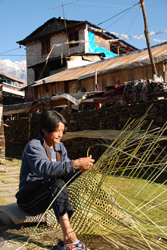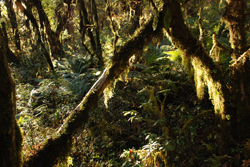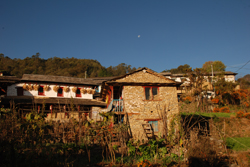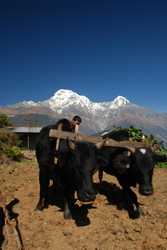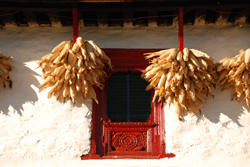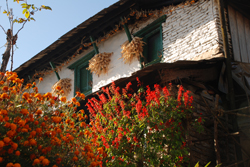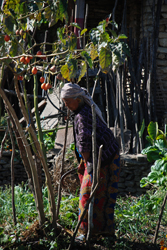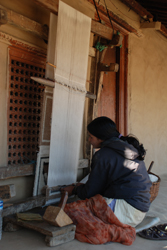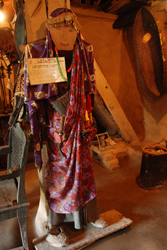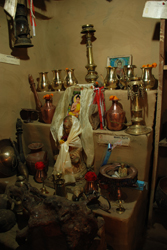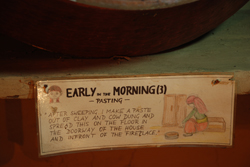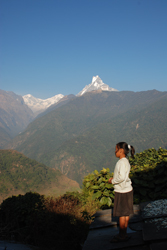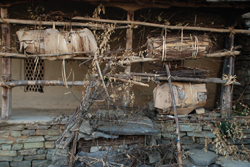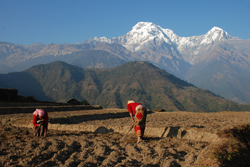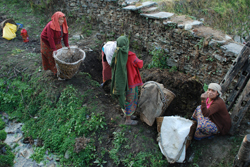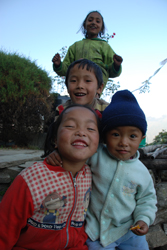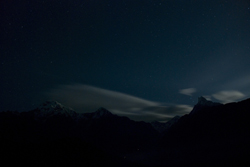Ghorepani Trek Day 4: Ghandruk a traditional Gurung Village
15 December, 2008, 02:12 am in "Nepal"
It was a short easy walk today of about 3 hours downhill. We left Tadapani where people were busy with their daily chores. The path led through more moss covered rain/cloud forest, redolent with ferns and ribboned through with a waterfall speckled river. Here and there were tiny purple or white flowers. A couple times we came upon clearings that opened out to views of the mountains looming across the valley. I love walking through cloud/rain forests. These forests are quieter than the hot jungles. They filter the sun's light like stained glass windows. They request a certain reverence. The waterfalls even seem quiet and secretive, hiding behind outcroppings of rocks. It is so amazing here. I keep wondering how come I hadn't known how beautiful Nepal is.
Ghandruk is a real village as opposed to a conglomeration of hotels. It has its share of hotels but most buildings seem to be real homes. It is a Gurung village which maintains its traditional look in spite of the masses of trekkers passing through.
As we arrived in the village we passed some men plowing a small field with a stunning view of the mountain. After we managed to drag ourselves away from our sun-drenched seat outside the hotel and the view of the mountains, we walked back through the town looking for the museum.
The town is on a mountainside and the stone houses are connected by a web of flagstone paths and stairs. The houses are care-takingly white washed and have ornate carved wood windows painted to match the roof struts. Gardens are overflowing with yellow, orange and red marigolds and other flowers, adding a touch of pink and purple. Pale yellow ears of corn hang drying under the eves. The town is quiet except for the occasional crowing of a rooster or rush of water in a stream through lush terraces filled with emerald bushes with corpulent leaves and lush grass.
Women sit in the sun talking or working, wearing rich colored clothing. One woman sat at a loom making traditional Gurung seat rugs from natural colored wools of gray and white. Along some of the paths, garlands of dried flowers were draped in modest festivity.
The museum was a room in the downstairs of a traditional house. The room was small but filled with artifacts of Gurung culture, lovingly curated and each containing a description in English of the item's use.
In the entrance of the museum were models of a man and woman in traditional clothing welcoming visitors to their house. Labels contained either a face of the man, Ram Bahadun Gurung, or the woman, Harimaya Gurung, or both signifying who utilized the objects. The labels were written as if either Ram or Harimaya were talking to the reader about the item. It was a creative way of presenting a lot of items and made reading about all the different artifacts very enjoyable.
In the entrance of the museum were models of a man and woman in traditional clothing welcoming visitors to their house. Labels contained either a face of the man, Ram Bahadun Gurung, or the woman, Harimaya Gurung, or both signifying who utilized the objects. The labels were written as if either Ram or Harimaya were talking to the reader about the item. It was a creative way of presenting a lot of items and made reading about all the different artifacts very enjoyable.
There were a couple small models: a wooden ferris wheel powered by 2 people, and a water mill. There were also lots of tools and a large number of different bamboo baskets and wood containers, each having a specific use. I pointed out some clay I saw in a wooden box, to Rowshan, then walked over to another section of the room and started reading about Harimaya's morning chores. A moment later I heard Rowshan exclaim, “This isn't clay, it's SHIT!”. He had pulled out a piece of the substance in the box and had been examining it when he recognized the smell. At that moment I read that Harimaya, every morning, spreads a mixture of clay and manure in front of the door and fireplace. This was called, “pasting”. There was also clay in the box but Rowshan had grabbed a piece of the other ingredient.
Among the other artifacts were a water pipe, weaving loom, butter churn, and a smaller churn for making butter tea. There were drums used by a lama for healing, an alter, and instructions for making Raxi, the local alcoholic drink made from fermented millet. As we were looking at the various items, a young girl came in and brushed the strings of a sarangi, tapped a drum and played with the butter churn, and the bracelets worn by the woman model. I assume she was the daughter of the curator. When we left, I opened the guest book. She made sure it was on the right page. I paid her the entrance fee and she stood looking at the money on the roof of the house, lower on the hill, and called something to someone within view.
The outside of the house also had plenty of interesting items including a hole leading underneath where chickens would live, and a log beehive. Earlier, Rowshan had noticed many bees flying around the marigolds and suggested we look for wild hives. I said people probably had boxes but I hadn't seen any. The hives were pieces of logs with holes in the side. After knowing what to look for we saw many set on the roof of the front porches of the houses or on the sides of the houses disguised with branches or corn husks. The museum info is: The Old Gurung Museum, Ghandruk 5, Kaski, Nepal, Curator: Uktaman Gurung, cost 30rs admission, hours 7am-7pm, open since 1992.
A little farther up the street we found another Gurung Museum. We didn't go in assuming it was the same, and probably an inferior knock off of the first which was so well prepared.
It must be kind of frustrating to have a good idea in Nepal because it will be unscrupulously copied. The 2nd museum was down the same street and even had its signs next to the signs of the first.
We continued our walk admiring the houses. Children raced past begging for sweets as they went. Rowshan took some photos of women digging up clay (I presume for pasting). In another field women were digging up potatoes.
It must be kind of frustrating to have a good idea in Nepal because it will be unscrupulously copied. The 2nd museum was down the same street and even had its signs next to the signs of the first.
We continued our walk admiring the houses. Children raced past begging for sweets as they went. Rowshan took some photos of women digging up clay (I presume for pasting). In another field women were digging up potatoes.
We eventually wandered back up the path cutting through the museum and entertaining a group of kids with Rowshan's camera. The path wound around and up past hotels and we came to the hotel. There had been a lot of fires today. People collect leaves from the forest and burn them in the fields for fertilizer.
Comments
- Comments
Powered by My Blog 1.69. Copyright 2003-2006 FuzzyMonkey.net.
Created by the scripting wizards at FuzzyMonkey.net..
(Code modified by Rowshan Dowlatabadi)
Created by the scripting wizards at FuzzyMonkey.net..
(Code modified by Rowshan Dowlatabadi)


